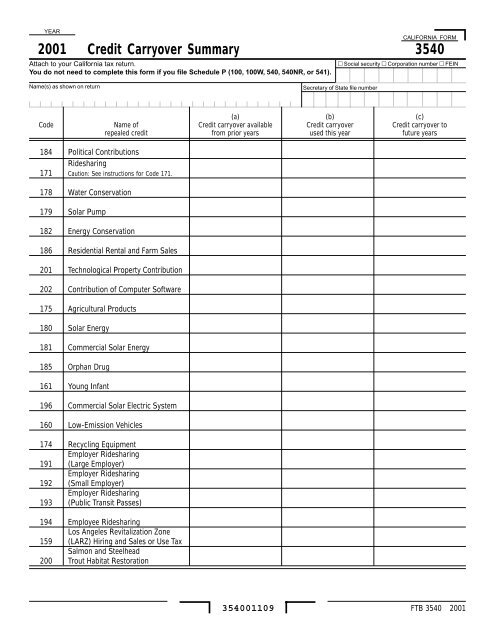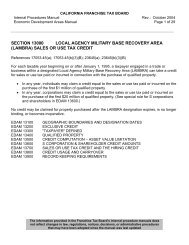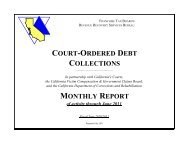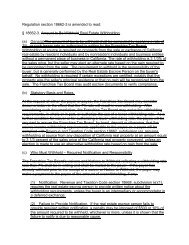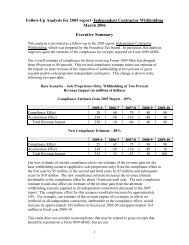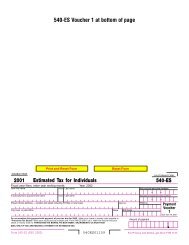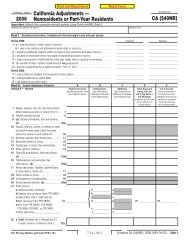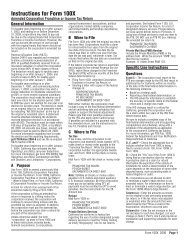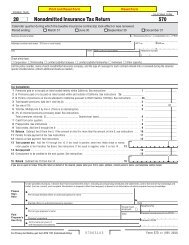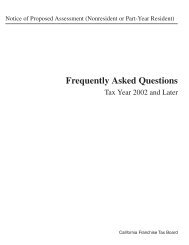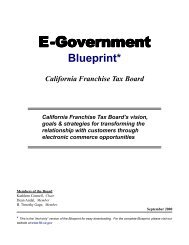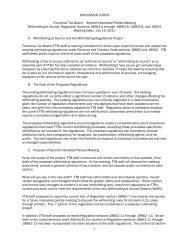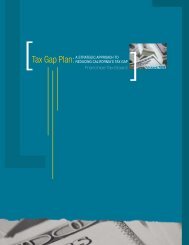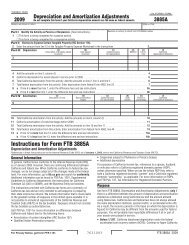2001 FTB 3540, Credit Carryover Summary - California Franchise ...
2001 FTB 3540, Credit Carryover Summary - California Franchise ...
2001 FTB 3540, Credit Carryover Summary - California Franchise ...
You also want an ePaper? Increase the reach of your titles
YUMPU automatically turns print PDFs into web optimized ePapers that Google loves.
YEAR<br />
<strong>2001</strong><br />
(a) (b) (c)<br />
Code Name of <strong>Credit</strong> carryover available <strong>Credit</strong> carryover <strong>Credit</strong> carryover to<br />
repealed credit from prior years used this year future years<br />
184 Political Contributions<br />
Ridesharing<br />
171 Caution: See instructions for Code 171.<br />
178 Water Conservation<br />
179 Solar Pump<br />
182 Energy Conservation<br />
186 Residential Rental and Farm Sales<br />
201 Technological Property Contribution<br />
202 Contribution of Computer Software<br />
175 Agricultural Products<br />
180 Solar Energy<br />
181 Commercial Solar Energy<br />
185 Orphan Drug<br />
161 Young Infant<br />
<strong>Credit</strong> <strong>Carryover</strong> <strong>Summary</strong><br />
Attach to your <strong>California</strong> tax return.<br />
You do not need to complete this form if you file Schedule P (100, 100W, 540, 540NR, or 541).<br />
Name(s) as shown on return<br />
196 Commercial Solar Electric System<br />
160 Low-Emission Vehicles<br />
174 Recycling Equipment<br />
Employer Ridesharing<br />
191 (Large Employer)<br />
Employer Ridesharing<br />
192 (Small Employer)<br />
Employer Ridesharing<br />
193 (Public Transit Passes)<br />
194 Employee Ridesharing<br />
Los Angeles Revitalization Zone<br />
159 (LARZ) Hiring and Sales or Use Tax<br />
Salmon and Steelhead<br />
200 Trout Habitat Restoration<br />
<strong>3540</strong>01109<br />
CALIFORNIA FORM<br />
<strong>3540</strong><br />
Social security Corporation number FEIN<br />
Secretary of State file number<br />
<strong>FTB</strong> <strong>3540</strong> <strong>2001</strong>
Instructions for Form <strong>FTB</strong> <strong>3540</strong><br />
<strong>Credit</strong> <strong>Carryover</strong> <strong>Summary</strong><br />
References in these instructions are to the <strong>California</strong> Revenue and Taxation Code (R&TC).<br />
General Information<br />
A Purpose<br />
Use form <strong>FTB</strong> <strong>3540</strong> to figure and claim a prior year credit carryover of<br />
one or more repealed credits that no longer have separate credit forms.<br />
<strong>Credit</strong> carryovers may not be carried back and applied against a prior<br />
year’s tax. The repeal dates for the credits listed below have passed.<br />
However, these credits had carryover features. You may claim these<br />
credits only if carryovers are available from a prior year(s).<br />
Note: You do not need to complete this form if you file Schedule P<br />
(100, 100W, 540, 540NR, or 541), Alternative Minimum Tax and <strong>Credit</strong><br />
Limitations.<br />
B <strong>Credit</strong> <strong>Carryover</strong><br />
You must use the credit code number listed to the left of the credit<br />
name when you enter the credit amount on your tax return.<br />
Code 184 – Political Contributions <strong>Credit</strong> <strong>Carryover</strong><br />
(Individuals only)<br />
You may claim a credit carryover for political contributions you made<br />
prior to January 1, 1992, under former R&TC Section 17053.14, only<br />
if a carryover is available from tax years 1987 through 1991.<br />
Note: The political contribution credit was the smaller of:<br />
25% of the amount contributed; or<br />
$50 ($25 for married filing separate and single).<br />
Code 171 – Ridesharing <strong>Credit</strong> <strong>Carryover</strong> (Pre-1989)<br />
You may claim a credit carryover for the cost of sponsoring a<br />
ridesharing program for your employees, or for operating a private,<br />
third-party ridesharing program under former R&TC Sections 17053,<br />
17053.1, and 23605, only if a carryover is available from pre-1989 tax<br />
years.<br />
Caution: Use Code 171 only for employer ridesharing credit carryovers<br />
from pre-1989 tax years. If you are claiming a credit carryover from<br />
the employer ridesharing vehicle credit available in tax years 1989<br />
through 1995, see codes 191 through 193 to determine which code to<br />
use.<br />
Code 178 – Water Conservation <strong>Credit</strong> <strong>Carryover</strong><br />
(Individuals, Estates, and Trusts only)<br />
You may claim a credit carryover for the costs of installing water<br />
conservation measures under former R&TC Section 17052.8, only if a<br />
carryover is available.<br />
Code 179 – Solar Pump <strong>Credit</strong> <strong>Carryover</strong><br />
You may claim a credit carryover for the cost of installing a solar pump<br />
system under former R&TC Sections 17052.1, 17052.4, 17052.8, and<br />
23607, only if a carryover is available.<br />
Code 182 – Energy Conservation <strong>Credit</strong> <strong>Carryover</strong><br />
You may claim a credit carryover for the costs of installing energy<br />
conservation measures under former R&TC Sections 17052.4,<br />
17052.8, and 23601.5, only if a carryover is available.<br />
Code 186 – Residential Rental and Farm Sales <strong>Credit</strong><br />
<strong>Carryover</strong><br />
You may claim a credit carryover if you had a gain from the sale of<br />
residential rental or farm property under former R&TC<br />
Section 17061.5, only if a carryover is available.<br />
Code 201 – Technological Property Contribution <strong>Credit</strong><br />
<strong>Carryover</strong> (Corporations only)<br />
You may claim a credit carryover if you contributed technological<br />
property under former R&TC Section 23606, only if a carryover is<br />
available.<br />
Code 202 – Contribution of Computer Software <strong>Credit</strong><br />
<strong>Carryover</strong> (Corporations only)<br />
You may claim a credit carryover if you contributed computer software<br />
under former R&TC Section 23606.1, only if a carryover is available.<br />
Code 175 – Agricultural Products <strong>Credit</strong> <strong>Carryover</strong><br />
You may claim a credit carryover if you donated agricultural products<br />
to a nonprofit organization under former R&TC Sections 17053.12 and<br />
23608, only if a carryover is available.<br />
Code 180 – Solar Energy <strong>Credit</strong> <strong>Carryover</strong><br />
You may claim a credit carryover for the costs of installing solar<br />
energy systems under former R&TC Sections 17052.5 and 23601, only<br />
if a carryover is available.<br />
Code 181 – Commercial Solar Energy <strong>Credit</strong> <strong>Carryover</strong><br />
You may claim a credit carryover for the costs of installing commercial<br />
solar energy systems under former R&TC Sections 17052.4 and<br />
23601.4, only if a carryover is available.<br />
Code 185 – Orphan Drug <strong>Credit</strong> <strong>Carryover</strong><br />
You may claim a credit carryover for expenses related to qualified<br />
clinical testing under former R&TC Sections 17057 and 23609.5, only<br />
if a carryover is available.<br />
Code 161 – Young Infant <strong>Credit</strong> <strong>Carryover</strong><br />
You may claim a credit carryover for a dependent under 13 months of<br />
age under former R&TC Section 17052.20, only if a carryover is<br />
available.<br />
Code 196 – Commercial Solar Electric System <strong>Credit</strong><br />
<strong>Carryover</strong><br />
You may claim a credit carryover for the costs of installing commercial<br />
solar electric systems under former R&TC Sections 17052.5 and<br />
23601.5, only if a carryover is available.<br />
Code 160 – Low-Emission Vehicles <strong>Credit</strong> <strong>Carryover</strong><br />
You may claim a credit carryover for the amount that was authorized<br />
by the CA Energy Commission under former R&TC Sections 17052.11<br />
and 23603, only if a carryover is available.<br />
Code 174 – Recycling Equipment <strong>Credit</strong> <strong>Carryover</strong><br />
You may claim a credit carryover for the purchase of qualified recycling<br />
equipment, which was certified by the CA Integrated Waste Management<br />
Board, under former R&TC Sections 17052.14 and 23612.5, only<br />
if a carryover is available.<br />
Code 191 – Employer Ridesharing <strong>Credit</strong> <strong>Carryover</strong><br />
(Large Employer)<br />
You may claim a credit carryover for the cost of sponsoring a<br />
ridesharing program for your employees or for operating a private,<br />
third-party ridesharing program under former R&TC Sections 17053<br />
and 23605, only if a carryover is available from tax years 1989<br />
through 1995.<br />
<strong>FTB</strong> <strong>3540</strong> Instructions <strong>2001</strong> Page 1
Use Code 191 if, in the year(s) in which the credit was generated, your<br />
available credit was computed using the Large Employer Program<br />
because you were an employer with 200 or more employees.<br />
Code 192 – Employer Ridesharing <strong>Credit</strong> <strong>Carryover</strong><br />
(Small Employer)<br />
You may claim a credit carryover for the cost of sponsoring a<br />
ridesharing program for your employees or for operating a private,<br />
third-party ridesharing program under former R&TC Sections 17053<br />
and 23605, only if a carryover is available from tax years 1989<br />
through 1995.<br />
Use Code 192 if, in the year(s) in which the credit was generated, your<br />
available credit was computed using the Small Employer Program<br />
because you were an employer with fewer than 200 employees.<br />
Code 193 – Employer Ridesharing <strong>Credit</strong> <strong>Carryover</strong><br />
(Public Transit Passes)<br />
You may claim a credit carryover for the costs paid or incurred for<br />
providing subsidized public transit passes to your employees under<br />
former R&TC Sections 17053 and 23605, only if a carryover is<br />
available from tax years 1989 through 1995.<br />
Code 194 – Employee Ridesharing <strong>Credit</strong> <strong>Carryover</strong><br />
(Individuals only)<br />
You may claim a credit carryover for the costs paid or incurred as an<br />
employee for non-employer sponsored vanpool subscription costs<br />
under former R&TC Section 17053.1, only if a carryover is available<br />
from tax years 1989 through 1995.<br />
Code 159 – Los Angeles Revitalization Zone (LARZ) Hiring<br />
<strong>Credit</strong> <strong>Carryover</strong> & Sales or Use Tax <strong>Credit</strong><br />
<strong>Carryover</strong><br />
You may claim a credit carryover for:<br />
Qualified wages paid to qualified employees under former R&TC<br />
Sections 17053.10, 17053.17, 23623.5, and 23625, only if a<br />
carryover is available; and<br />
Sales or use tax paid or incurred on qualified property under<br />
former R&TC Sections 17052.15 and 23612.6, only if a carryover<br />
is available.<br />
Caution: The amount of credit carryover you may claim for the LARZ<br />
hiring credit and LARZ sales or use tax credit is limited by the amount<br />
of tax on business income attributable to the former LARZ. Get <strong>FTB</strong><br />
3806, Los Angeles Revitalization Zone Business Booklet, to determine<br />
the amount of credit carryover you may claim.<br />
Code 200 –Salmon and Steelhead Trout Habitat Restoration<br />
You may claim a credit carryover for the cost associated with salmon<br />
and steelhead trout habitat restoration and improvement projects<br />
under the former R&TC Sections 17053.66 and 23666, only if a<br />
carryover is available. The credit amount is the lesser of 10% of<br />
qualified costs, or other amounts determined by the <strong>California</strong><br />
Department of Fish and Game.<br />
C Limitations<br />
In most cases, a credit carryover cannot reduce the minimum franchise<br />
tax (corporations, S corporations) and the annual tax (limited<br />
partnerships, limited liability companies (LLCs), limited liability<br />
partnerships), the alternative minimum tax (corporations, exempt<br />
organizations, individuals, and fiduciaries), the built-in gains tax<br />
(S corporations), or the excess net passive income tax<br />
(S corporations).<br />
Page 2 <strong>FTB</strong> <strong>3540</strong> Instructions <strong>2001</strong><br />
However, the solar energy credit carryover and the commercial solar<br />
energy credit carryover may reduce alternative minimum tax. Get<br />
Schedule P (100, 100W, 540, 540NR, or 541), Alternative Minimum Tax<br />
and <strong>Credit</strong> Limitations.<br />
If the available credit carryover for the current taxable year exceeds the<br />
current year tax, any unused amount may be carried over to succeeding<br />
years unless the credit carryover period has expired. Apply the<br />
carryover to the earliest taxable year(s) possible.<br />
Note: In no event can a credit carryover be carried back and applied<br />
against a prior year’s tax.<br />
Single Member LLCs (SMLLC)<br />
If a taxpayer owns an interest in a disregarded business entity, (an<br />
SMLLC not recognized [disregarded] by <strong>California</strong> for tax purposes<br />
that is treated as a sole proprietorship owned by an individual or a<br />
branch owned by a corporation) the credit amount received from the<br />
disregarded entity that can be utilized is limited to the difference<br />
between the taxpayer’s regular tax figured with the income of the<br />
disregarded entity, and the taxpayer’s regular tax figured without the<br />
income of the disregarded entity. An SMLLC may be disregarded as an<br />
entity separate from its owner, and is subject to statutory provisions<br />
that recognize otherwise disregarded entities for certain tax purposes.<br />
Get Form 568, Limited Liability Company Income Tax Return, for more<br />
details.<br />
Note: If the disregarded entity reports a loss, the taxpayer may not<br />
claim the credit this year but can carry over the credit amount received<br />
from the disregarded entity.<br />
Corporate Members of a Unitary or Combined Group<br />
The credit carryover cannot be allocated or otherwise transferred to<br />
another taxpayer, even if the other taxpayer is a member of a unitary or<br />
combined group or otherwise affiliated with the taxpayer that earned<br />
the credit from which the credit carryover originated.<br />
Specific Line Instructions<br />
Column (a) – Enter the amount of credit carryover available from prior<br />
years. This amount is found on the prior year credit form or statement<br />
that you attached to your previous year’s tax return. This amount may<br />
also be found on the prior year Schedule P, Alternative Minimum Tax<br />
and <strong>Credit</strong> Limitations, under <strong>Credit</strong> <strong>Carryover</strong>, column (d).<br />
Column (b) – Enter the amount of credit carryover claimed on your<br />
current year tax return. The credit carryover amount you can claim on<br />
your tax return may be limited by federal adjusted gross income and<br />
by <strong>California</strong> tentative minimum tax (TMT). Refer to the credit<br />
instructions in your tax booklet to determine the amount of credit<br />
carryover you can claim and for information on claiming the credit<br />
carryover on your tax return. Also see General Information C,<br />
Limitations.<br />
Column (c) – Subtract the amount in column (b) from the amount in<br />
column (a). Enter the result in column (c). This is the amount of credit<br />
that can be carried over to future years. See General Information C,<br />
Limitations.


